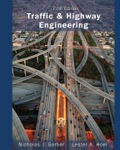
Traffic and Highway Engineering
5th Edition
ISBN: 9781305156241
Author: Garber, Nicholas J.
Publisher: Cengage Learning
expand_more
expand_more
format_list_bulleted
Concept explainers
Question
Chapter 3, Problem 21P
To determine
The breaking distance to stop an average passenger car.
Expert Solution & Answer
Trending nowThis is a popular solution!

Students have asked these similar questions
A one-story building as shown in the plan, if the height of the concrete floor is 320 m,
the width of the wall is 0.24 and the roof is made of reinforced concrete, the amount
of iron for the roof is 100 kg m3 and there are downward depressions with a depth
of 0.40 and a width of 0.25 along the wall and the amount of reinforcing iron is 89 kg
m3 and there are 14 columns with dimensions of 0.500.30 and a height of 2.80, the
amount of reinforcing iron is 120 kg m3
Find
The amount of bricks used for construction
The amount of mortar used for construction (cement + sand)
-1
-2
The amount of plaster for the building from the inside is 2 cm thick (cement + sand) -3
Quantity of floor tiles for the room
Quantity of concrete for the ceiling and beams. Ceiling thickness: 0.20 m.
Total amount of reinforcing steel for the roof (tons)
Quantity of reinforcing steel for columns (tons)
Total amount of reinforcing steel for balls (tons)
-4
-5
-6
-7
-8
K
Course Code
CE181303
Course Title
Hours per week
L-T-P
Credit
C
Fluid Mechanics
3-1-0
MODULE 1: Fluid Properties:
Fluid-definition, types; physical properties of fluid-density, specific weight, specific volume, specific
gravity, viscosity- Newton's law of viscosity, surface tension, compressibility of fluids, capillarity.
MODULE 2: Fluid Statics:
Hydrostatic pressure, pressure height relationship, absolute and gauge pressure, measurement of
pressure-manometer, pressure on submerged plane and curved surfaces, centre of pressure; buoyancy,
equilibrium of floating bodies, metacentre; fluid mass subjected to accelerations.
MODULE 3: Fluid Kinematics:
Types of motion- steady and unsteady flow, uniform and no uniform flow, laminar and turbulent flow,
and path lines, stream tube, stream function
compressible and incompressible flow, one, two & three dimensional flow; stream lines, streak lines
and velocity potential, flow net and its drawing: free and forced vortex.
MODITE
Q. A closed…
H.W: For the tank shown in figure below, Find The amount of salt in the tank
at any time.
Ans: x = 2(100+t)
1500000
(100 + t)²
Qin = 3 L/min
Cin = 2 N/L
V = 100 L
Xo=50N
Qout = 2 L/min
Cout?
33
Chapter 3 Solutions
Traffic and Highway Engineering
Knowledge Booster
Learn more about
Need a deep-dive on the concept behind this application? Look no further. Learn more about this topic, civil-engineering and related others by exploring similar questions and additional content below.Similar questions
- - Find reactions and draw Shear and Bending Moment Diagram. 30 N 15 N/m D B A 2 m 1 m 2 mmarrow_forward: A 5ms- long current pulse is desired for two linear lamps connected in series and pumped at a total energy input of (1KJ). Each of lamps has an arc-length of (10cm) and a bore of (1cm). If we assume a peak current of (i, -650A). Design a multiple mesh network including number of LC sections, inductance and capacitance per section and capacitor voltage. Laser designarrow_forwardWhat would be the best way to handle when a contractor misses a concrete pour deadline which causes delays for other contractors?arrow_forward
- Please solve manuallyarrow_forward. The free fall distance was 1753 mm. The times for the release and catch recorded on the fall experiments were in millisecond: 222.22 800.00 61.11 641.67 0.00 588.89 11.11 588.89 8.33 588.89 11.11 588.89 5.56 586.11 2.78 583.33 Calculate the time taken for the fall for each experiment. Calculate for each fall the acceleration based on time and distance. Calculate the mean of the accelerations. Give in the answer window the calculated mean of accelerations in m/s2.arrow_forwardneed help. explain plzarrow_forward
- -Design the traffic signal intersection using all red 2 second, for all phase the truck percent 5% for all movement, and PHF -0.95 Check for capacity only Approach Through volume Right volume Left volume Lane width Number of lane Veh/hr Veh/hr Veh/hr m North 700 100 150 3.0 3 south 600 75 160 3.0 3 East 300 80 50 4.0 R west 400 50 55 4.0 2arrow_forwardneed helparrow_forwardFor the beam show below, draw A.F.D, S.F.D, B.M.D A 2 N M 10 kN.m B 2 M Carrow_forward
- B: Find the numerical solution for the 2D equation below and calculate the temperature values for each grid point shown in Fig. 2 (show all steps). (Do only one trail using following initial values and show the final matrix) T₂ 0 T3 0 I need a real solution, not artificial intelligence locarrow_forward: +0 العنوان use only Two rods fins) having same dimensions, one made orass (k = 85 Wm K) and the mer of copper (k = 375 W/m K), having of their ends inserted into a furna. At a section 10.5 cm a way from furnace, the temperature of brass rod 120 Find the distance at which the ame temperature would be reached in the per rod ? both ends are ex osed to the same environment. ns 2.05 ۲/۱ ostrararrow_forwardI need a real solution, not artificial intelligencearrow_forward
arrow_back_ios
SEE MORE QUESTIONS
arrow_forward_ios
Recommended textbooks for you
 Traffic and Highway EngineeringCivil EngineeringISBN:9781305156241Author:Garber, Nicholas J.Publisher:Cengage Learning
Traffic and Highway EngineeringCivil EngineeringISBN:9781305156241Author:Garber, Nicholas J.Publisher:Cengage Learning

Traffic and Highway Engineering
Civil Engineering
ISBN:9781305156241
Author:Garber, Nicholas J.
Publisher:Cengage Learning